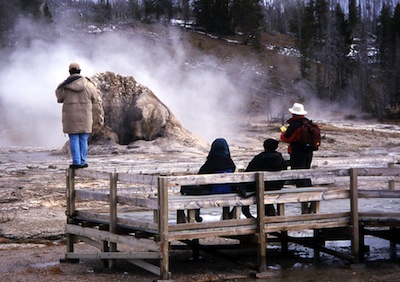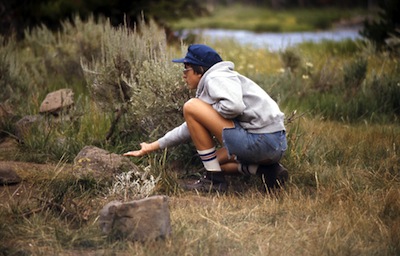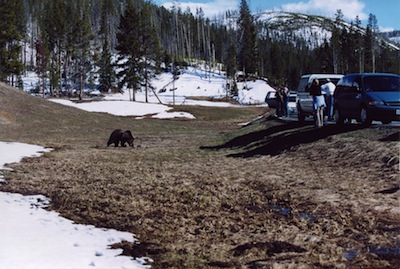
Child safety remains high priority in parks
In every national park across the country, there are important child safety concerns.
And while large numbers of parents and children who visit these parks each year know how to stay safe, there are many people who are unaware of some of the most severe safety concerns posed by national parks.
Yellowstone National Park, located primarily in Wyoming but also extending into Montana and Idaho, is an extremely popular park. When you visit, however, there are certain child safety concerns that you should keep in mind.
| Click on the video at left to view an audio slide show narrated and prepared by writer Allison Gordon. Images courtesy of the National Park Service. |
According to Al Nash, public affairs officer for Yellowstone National Park, the park has several areas of concern.
“The biggest public safety challenges for Yellowstone surround thermal areas and wildlife in the park,” he explained.
Thermal areas in Yellowstone include hot mud pots and hot springs, and these areas can be dangerous for everyone – especially young children. These areas can be boiling hot and it is important, said Nash, to keep your hands away from the hot water and mud.
It is also extremely important to make sure to stay on the marked trails in the park and keep an eye on children during hikes. There are boardwalks that have been built over the dangerous hot areas, and staying on the boardwalks and trails is integral to staying safe, Nash said.
“People don’t realize that the crust around these thermal areas can be thin – they don’t support weight well,” explained Nash.
The thermal areas in Yellowstone National Park are only the beginning of the safety concerns. Wild animals, especially bears, bison and elk, also give parents a reason to be anxious about the safety of their children.
| Standing on the edge of a fence, like this man is doing, is not safe and is setting a bad example for the children watching him (Photos courtesy of the National Park Service). |  |
These animals, however, are not usually dangerous – unless you get too close.
“This is a concern because people sometimes mistake animals not responding immediately to their presence as animals being tame. This is not the case,” described Nash.
Nash described a scenario that happens often: parents driving with children see an animal on the side of the road and stop their car to take pictures. Naturally, cars behind the first car stop as well and more people begin taking pictures. This creates a huge traffic jam, and when people start getting out of their cars to take pictures, it really becomes a safety hazard.
These animals, such as bears, moose, elk and bison, are quite large and unpredictable. They can be dangerous and people should stay at least 100 yards (a football field’s length) away from the wild animals explained Nash. Parents really need to set good examples for their children.
Park rangers do roam the park, making sure to keep both parents and children safe. These rangers say it is their primary goal to make sure everyone enjoys the park, however this must be done in a safe way.
According to Nash, the main ways to be safe from wild animals without the park rangers are to travel in groups of at least three, to not carry any smelly foods, and to make loud noises when walking around a corner if you cannot see what is on the other side.
The most extreme way to keep away bears, however, is to carry with you pepper spray.
| The boy in this photograph is trying to feed a squirrel and, even though small animals like squirrels are not extremely dangerous, feeding any animals in the national parks is an obvious safety violation. |  |
“It’s not normal pepper spray,” said Nash, “It is a one liter bottle that is sold around the park and it has proved effective with aggressive bears.”
Yellowstone National Park is just one of the many popular national parks in which safety is a major concern. Another very popular park with similar safety issues is the Grand Canyon.
This park creates many safety concerns for parents and children, but not for the reason one would expect.
The biggest safety concern at the Grand Canyon is not, according to Dave Cane, safety manager at the park, parents worrying about their children falling over the canyon’s edge.
“The biggest concern here is people underestimating the canyon and over-exerting themselves on hikes,” said Cane.
The Grand Canyon rim is at a very high altitude, about 7,000 feet, and knowing your personal limit on hikes is important. Walking down a trail, such as Bright Angel in the South Rim Canyon Village, can take visitors down as much as 5,000 vertical feet. Returning to the rim is challenging for even the best conditioned hikers.
Cane also mentions how important it is to eat and stay hydrated on all hikes you embark on.
 |
Visitors stepping out of their cars to take pictures of a bear is not the best idea, especially this close. It is important to stay at least 100 yards away from wild bears which these people are clearly not doing. |
Aside from making sure not to go over your physical limit on canyon hikes, the safety concerns at the Grand Canyon are similar to those of other national parks: Keep a distance between yourself and wild animals encountered, do not wander off the trails, listen to park rangers, and keep a close eye on children.
According to Cane, the search and rescue team at the Grand Canyon is very efficient.
“We have EMS, search and rescue, and helicopters, but what’s a quick rescue is relative. Our team is very proficient, but it takes time to find people when they are lost in the park,” explained Cane.
Staying safe when visiting national parks around the United States is essential in enjoying the national parks, and by listening to park rangers and following common sense, everyone can safely enjoy the parks and what they have to offer.
If You Go
Remember to bring snacks (not smelly) and lots of water if you are planning to go on long hikes.
Remember to listen to park rangers and follow all signs.

Comments are Closed